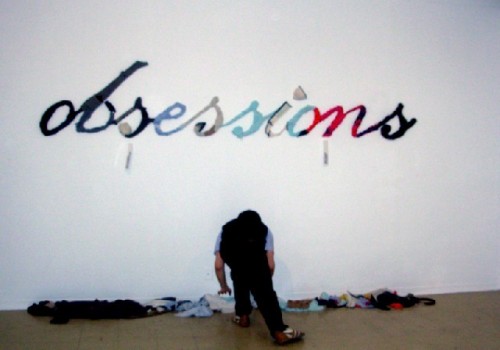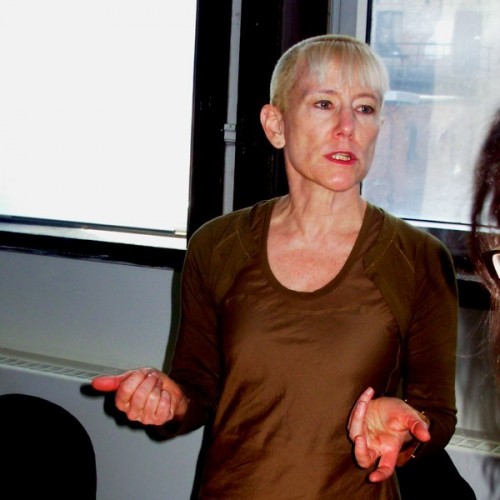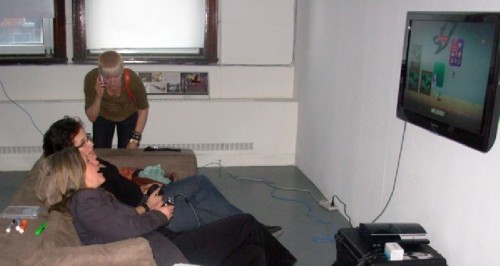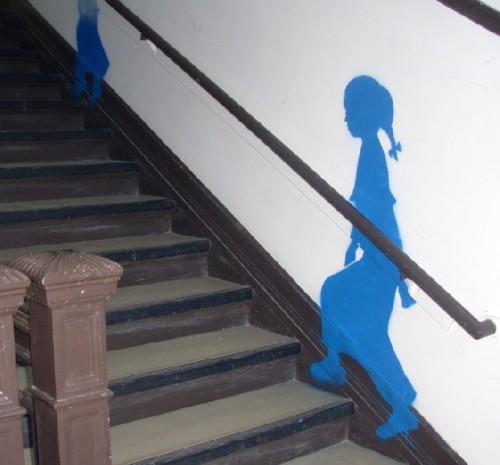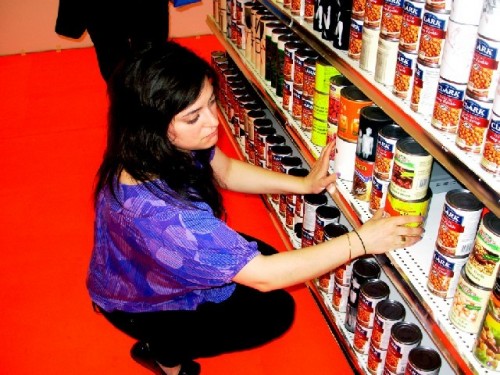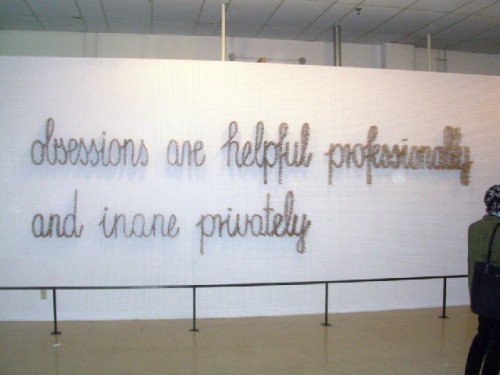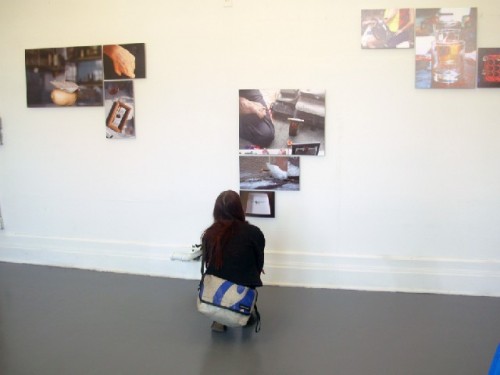Canadian Curator Claude Gosselin 2
Designing Biennials for Younger Audiences
By: Claude Gosselin and Charles Giuliano - Mar 08, 2012
Claude Gosselin The visual arts as an object is in the middle of a strange world now. The new works are mainly into digital art. I phones, films. The new technologies. When you have exhibitions of paintings, sculptures. Some environments. Video art. It’s not something for young people to run after.
In 2009 our theme for La Biennale de Montreal was about Open Culture. The works being open to others and the artist as the main producer. The main person behind the work. But he makes the work open to the public.
Charles Giuliano We covered that event with work which was very difficult. There seemed to be a generational gap.
Claude This is what I was going to say. At this Biennale we had a lot of people under 25. The kids had fun. I must say I think it was for us a summit of attendance from the younger generation. For those over 35, to give the spectrum, they were lost in this kind of art. People let’s say 40 and over they would prefer to spend their time looking at paintings with a contemplative attitude. They know the references and the art history. So they are at ease with that. With the new digital art they’re lost. They’re not the ones playing with the I Phones. They don’t go to underground events. There is a break now between generations. I was just meeting with a lady who is involved with film. She said that she recently had a conversation with students at Concordia University. She was asking what kind of art do you do and where do you want to go? Everyone answered that we want to go into new media and new technologies.
Showing a painting. Showing a sculpture. It’s very difficult today. I must say there is a little exception with drawings. Because street art is kind of a drawing. Graffiti. Also people like doing little drawings. So drawing is strong with the new generation. Because it’s not as ‘fine arts’ as they like to describe these things.
CG And yet if you go to the global events, Venice, documenta, the Whitney Biennial it is about huge installations and epic works. When we came to your Biennale in 2009 we were disoriented. But I admire your freshness in being willing to change and experiment. And I give us credit for seeking out and trying to comprehend changes that are occurring. For us the 2009 experience represented a challenge and learning curve. We live up the street from Mass MoCA so we are constantly presented with new approaches to contemporary art. You have to be flexible and adapt to developments in the field. But as senior citizens we’re not as nimble as we used to be.
Claude That’s why I feel that we are in the middle of a kind of Renaissance. Leaving where we used to look at the landscape. The visual arts system. Into a new system for the visual arts. So that’s why it’s not easy to look at the old way of doing things. Compared to the new attitudes toward art. The permanency of the work is one of the things. The younger generation are so into the immediate. I’m not sure they care about tomorrow very much. They are not involved with keeping the work and making sure it will last for some years.
CG Can we discuss First Nation artists in Canada? We see little or nothing of this work in the mainstream of the American art world. Is there a difference in Canada? To what extent have you dealt with this work in your program?
Claude In the last Biennale we had an artist. Overall I have presented about five First Nation artists.
CG How important is First Nation art when it comes to government support?
Claude They don’t make the difference when they apply. There is no special money for First Nation artists. They like when they see them as a part of our exhibitions. In terms of the Council for the Arts there is no section for the First Nation artists. It’s not bad as they may be seen as a special group of artists. Instead they are put together with the non First Nation. We have curators across Canada working with them and we are seeing First Nation artists more and more particularly in publications. The First Nation students are also attending schools in the South so they are not just doing traditional work they are involved with the subjects of contemporary culture.
CG Compared to the U.S. it seems that there is a lot of support for Canadian artists.
Claude The federal government with its Council for the Arts has a budget for Canadian artists. Quebec and most of the provinces have their own Councils for the Arts. They are giving money to artists as well. The cities are mainly giving money to institutions for presenting the works of the artists. Compared to The States this whole money is more than the National Endowments for the Arts. We know that the NEA is not giving a lot of money to individual artists.
CG It’s the law. After the Mapplethorpe/ Serrano/ Finley controversy Congress voted that no individual artists receive direct NEA money. It goes to institutions which promote artists through their programming.
Claude But you have more non governmental foundations where artists can apply for money. For the leading artists the market is there. In Canada we have a very small market for the arts so we have to compensate by allowing individuals to buy bread.
CG Can Canadian artists support themselves with their work?
Claude Very few. I think the average revenue for artists is around $25,000 a year. Very few will only survive with their sales. They have to be teachers in schools. Working in a school or university makes you so busy with administration, giving lectures and helping students, there is less time for your own creativity and work. You don’t have to struggle and are a part of the secured world. So the urgency is not the same as being a freelance artist. When artists join the university they go into a mold and complain about the administration. They stay there because it is secure. We were talking with a friend of ours. He maintains a strong creativity because that is his spirit. He was telling us that he is so fed up with all the reports that he has to do that will just stay in a closet. The administration is asking details and details. At the end is nothing that comes out of this. He is fed up with the university. They are like little governments. They live within their own rules.
CG Regarding the issue of having contemporary Canadian art seen abroad we have just such a project coming to Mass MoCA this summer. I hope you saw the dialogue I conducted with the curator Denise Markonish. This is an in depth survey of 65 artists sponsored by a major American museum. Because of the importance of the venue the exhibition will receive the kind of critical attention that you discuss as difficult to generate in Canada. This would seem to serve a lot of your mandates. It is the first such American survey on this level. Perhaps I am wrong.
Claude Perhaps it is the first large one with Canadian exposure. I do not know of any other. This is kind of a second attempt of showing Canadian art abroad. There was a similar project in the early 1980s in Austria. It was badly received. It was organized by the National Gallery. Now we have the same kind of panorama of Canadian artists from East to West and North to South. Without any thematic outside of living in Canada. I do not know which works these people will be showing. It’s a new generation of artists. A younger generation of artists. That is a generation which is in between the visual arts as we know them up to the 1970s. In the 1980s they are starting on working on objects with no special significance of being nice objects for selling in art galleries. You have no people from the younger generation (in the Mass MoCA survey) working in the new media. Young artists from Canada are very much recognized for these new technologies. And media art.
CG So that’s not represented in this exhibition?
Claude I don’t think you have anyone. There are some videos. But it is the traditional way of making a video and showing a video installation. Montreal is represented by only one gallery. They’re ok. But they are not the best of Montreal. The gallery is Parisian Laundry.
CG We know that gallery. They hosted the benefit for the 2009 Biennale.
Claude That’s right. The owner of that gallery is on our board. (laughs) I will ask you to be kind. The artists who have been selected have good reports from critics in Montreal but they’re not the ones I’m supporting. I’m telling you about me. My own feelings about the selection of the artists. Other curators are saying that these artists are good. BGL (Bob, George and Lucian) has been accepted by everyone. Now in the past reports they are saying that maybe BGL their works were better before. They are starting to have a new looks at the works and their appraisal. They’re three guys from Quebec. People have been very good with them but I’ve never been able to take their works. They know that I’m not keen on their work. But they had a special show at the Montréal Museum of Contemporary Art. They had a show at the Museum of Fine Arts. They have been everywhere. Museums are buying their works. But it is not my cup of tea. (laughs)
CG Were you contacted or consulted for the Mass MoCA project?
Claude Not directly. No. Not indirectly either. I don’t know who she met from Montreal. There’s no artist from Rene (Blouin). Or Pierre-François Ouellette art contemporain (PFOAC). The leading Montreal galleries are not represented.
CG Perhaps there was the perception that these are the grandfather galleries.
Claude Yes but perhaps they have the best artists as well.
CG Young curators prefer to work with their own generation. That’s not unusual or surprising.
Claude I don’t have the list of all the artists selected for Mass MoCA but I think she has old and new.
CG Do you plan to see the show?
Claude Yes. If not for the opening then by the first weekend.
CG What impact do you anticipate for the Mass MoCA exhibition?
Claude I doubt very much that there will be any impact at all. The good galleries, say Catriona Jeffries Gallery from Vancouver, will have artists in the show. She is one of the good galleries from across Canada. She goes to the art fairs and she is probably already working on what people in the States will be looking at her works in the show. So the impact will come from the galleries. The individuals behind the artists working on the promotion. Where it is about the right people for their artists. As a whole this is where it is always more difficult. If you have critics looking at this whole thing they may say “Well there are good artists. But are we looking at a Canadian point of view? Or a specificity for Canada?” That will be very difficult to find in the exhibition. It becomes individual artists presented in Mass MoCA.
CG With 65 artists that’s quite a broad representation.
Claude I am curious to see which ones the Americans will select as the best ones. Sometimes these shows are difficult for the galleries. Because they have no say on the other artists represented in the show. They may be totally against the aspect of art that these other artists are representing. That’s why they have to make a strong presentation to the press and critics to make sure that their artists won’t be leveled by the other ones.
CG Biennials are changing. Did you read the Roberta Smith review of the new Whitney Biennial in the New York Times?
Claude No.
CG She was very enthusiastic. Have you followed what the Whitney is doing this time?
Claude Not Really.
CG They have allotted one floor of the museum to performance. Not performance art in the usual sense but rather alternative theatre and dance companies. They will rehearse in the space and have a series of performances then the schedule will change and another group will occupy the space. The New York audience will have to make repeated visits in order to see a full representation of the program. They are also having fewer works and more space. We will see it in April. But it seems more focused and less crowded. If the Times is an indication it seems that there is a change in approaching the Biennial.
Claude That confirms the fact that we are much more into the moment than the long term kind of products. With the performance it is become a show with different rules. It shows that the visual arts are not attracting a lot of people now. The museums are moving into the performing arts. The Whitney Biennial has to survive. If they want to attract a new generation then they have to go toward what the new generation wants to look at. The new generation is more interested in being part of something. Interactivity with the public. Performance art is often a part of the interactivity with the public.
For me it just confirms that looking at a series of photos or paintings or sculpture is non viable for museums anymore. Which is completely wrong. We have the same problem in Montreal. The museums are not helping the public to understand the visual arts. We are bombarded with publicity and publicity has to go very strongly with the consensus for the publicity to be understood especially in a very short period of time. You have 60 seconds 30 seconds. So you have to work in a defined consensus of images in order to understand the language. In the visual arts the artists are proposing a new language and the museums are not working hard enough to explain visual arts.
Instead of explaining it, we are working within a realm of images, and the museums are getting out of that. Instead of fighting for that and making sure that people will be keen and interested in knowing how the language works. They are opting out of their own specific needs and reason for being, toward the performing arts. The Montreal Museum of Fine Arts are now into music. The Montreal Museum of Contemporary Art now has special events with DJ’s, every Wednesday nights or Friday nights. When they have exhibitions they don’t really talk about looking at the work of art. The curators don’t know how to speak about their own medium.
It’s a bit complicated to talk about. But the museums are lacking in regard to what is our mandate? We have to reflect on this mandate. To fight for the images and the way that images are built up. The way people see. The way people understand an image. Things like that. Instead of just showing the work and saying it’s a good work. It comes from this gallery or this collector.
Museums in Montreal are not working on large group shows with one theme. For years I have not seen in Montreal an exhibition developed with a thematic focus. It is only through thematic exhibitions that people will come to understand the reasons for these works. Museums are like private galleries now.




